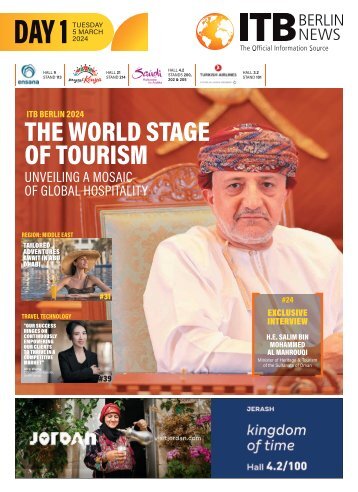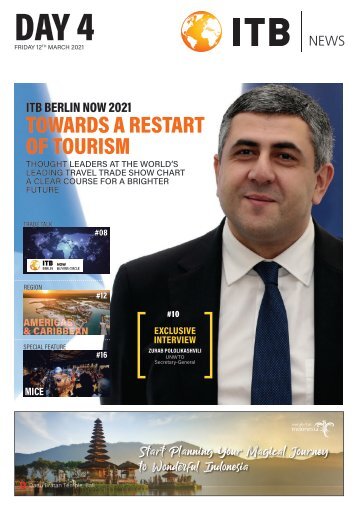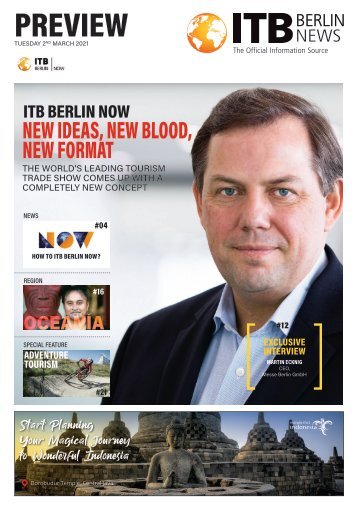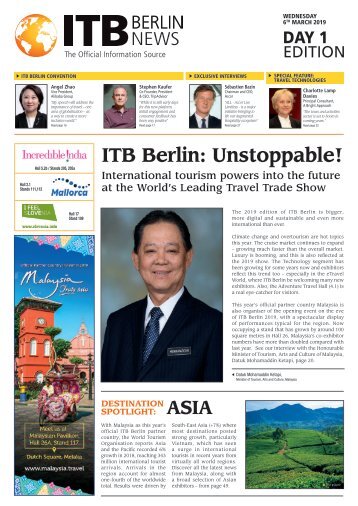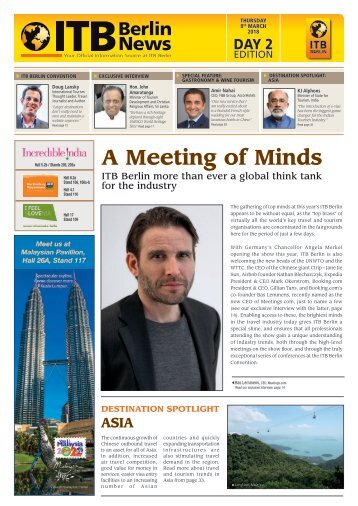
ITB Berlin News - Day 2
- Text
- Tourism
- Hotels
- Resort
- Tours
- Resorts
- Berlin
- Exhibitors
- Halle
- Tourismus
- Aussteller
44 REGION ADVERTORIAL
44 REGION ADVERTORIAL ASIA A cave in the Gangala valley with Banyan trees Priestess performing a ritual at a burial site in Shuri castle Mushroom-shaped rock at the beach in Yomitan Diving into Prehistoric Times With its limestone labyrinths, bizarre stone formations and coral rocks, Japan’s most southern prefecture Okinawa allows unique glimpses into the early days of man and nature “Gang, Gang, Gangala, Gangalala, Gangalalala!” is the sound a little stone makes rolling down into a deep cave in the south of Okinawa’s main island. Suddenly, there is silence as if you are set back to the beginning of everything. In the beginning, so ancient songs tell, there was the goddess Amamikyu who gave birth to the island of Kudaka, and then to all other islands of the Ryukyu archipelago. Next, she created people, lending them five types of grain, and life began. In fact, scientific evidence of very early life can be found along the subtropical beaches of Okinawa plentifully. The oldest fossils known to man, minuscule shells called Foraminifera, make up the shiny star-shaped sand of many shores. Over 200 different shapes of Foraminifera have been counted on the island of Miyako alone. Okinawa’s star-sand tells the story of the Cambrian explosion about 500 million years ago, when life burst into numerous forms, some of which would become our very distant ancestors. A cradle of Okinawan people may be near the Gangala Valley, a dozen kilometers southwest of the prefectural capital Naha on the main island of Okinawa. There, visitors can take spectacular guided tours into ancient caves and prehistoric burial places. It was 1968 when a local archaeologist discovered human remains dating back more than 18,000 years. The discovery of the Minatogawa group, which is some of the best-preserved evidence of the existence of homo sapiens in eastern Asia, was a sensation and continues to keep researchers excited. Prehistoric men and animals found their way to Okinawa during the last glaciation event, when the drop in sea level created a land bridge between the Ryukyu archipelago, Taiwan, and the Asian continent. Later on, when the ice melted again, the ocean served as a safety barrier, which is why many endemic species have survived on the islands, whereas they became extinct elsewhere. Cycas revoluta, fern trees and gigantic palms are home to Okinawa. Rare animals include the flightless rail Kuina, which lives in the Yanbaru forest, or the Iriomote mountain cat, a subspecies of the leopard cat, which can only be found on Iriomote Island – a nature lover’s paradise and Japan’s Amazon. The islands of Okinawa are shielded from the rough Pacific Ocean by vast coral reefs, which also built large parts of the land. Coral reefs appeared in the Ryukyu arc about 400,000 years ago. For millenia the forces of nature carved the land creating bizarre stone formations and mysterious worlds. Visitors can meander in mile-long limestone labyrinths or discover mushroom-like rocks, which reveal magical cut-outs when the sun is setting during the tides. Astonishingly regular rock shapes, such as the Tatami stones on the island of Kume, or the impressive underwater monument near Yonaguni Island, make adventurers dream about a culture lost and forgotten long ago. Nature has strongly influenced the islanders and their way of life. Numerous chants, poems and old rites praising her were past on for generations and are alive today. Yet, with the centuries Ryukyuans also learned to shape nature to their own use. Massive examples are the Gusuku sites, which are recognized as world cultural heritage. These large stonewalls built from coral reef blocks surround sacred places and fortresses on many islands. No less impressive are the ways traditional villages were designed, with roads and houses being shielded by strong Fukugi trees in order to restrain the winds and ease the summer’s heat. Hall 26A / Stand 129 OKINAWA TRAVEL INFORMATION @ ITB: Hall 26 a, No. 129 OKINAWA CONVENTION & VISITORS BUREAU (OCVB): http://en.okinawastory.jp/ WORLD CLASS MUSEUMS IN OKINAWA: • Okinawa Prefectural Museum & Art Museum •Okinawa Churaumi Aquarium • Oceanic Culture Museum World Cultural & Natural Heritage sites: • Gusuku Sites and Related Properties of the Kingdom of Ryukyu • Seifa Utaki, the greatest sacred site of the Ryukyu Kingdom and ancient place of worship • Yanbaru forest (under application), subtropical rain-forest NATIONAL PARKS IN OKINAWA: • Kerama Islands, famous for their clear waters, coral reefs and diversity of landscapes • Iriomote-Ishigaki National Park, pristine mangrove forests and subtropical flora and fauna BOOK RECOMMENDATION (available @ ITB bookstore): Okinawa – Unterwegs in Japans südlichen Landen, ISBN: 978-3-9815168-3-8. The first German popular science book about Okinawa’s nature, history & culture since 1927. ITB BERLIN NEWS • Thursday 10 th March 2016 www.itb-berlin-news.com
ASIA REGION 45 The Rising Sun of Tourism International tourism remains a bright spot in a slowing Japanese economy Kamakura, Japan While Japan’s economy is slowing, tourism is not. For the first time in 45 years, Japan recorded more inbound than outbound travellers. The country experienced an amazing 47.3% increase over 2014 with total foreign arrivals jumping from 13.41 million to 19.73 million. Total revenues increased even more dramatically, up by 71.5% over 2014 to reach a record ¥3.48 trillion, approximately the equivalent of US.5 billion. The success of Japanese tourism is supported by two factors: the lifting of visa requirements for most travellers from Asia; the weakening of the yen to a basket of other currencies and a burgeoning middle class from China – they represent now close to 5 million travellers a year. This represents a growth of almost 100% over 2014. Other million-visitor inbound markets include South Korea, Taiwan, Hong Kong and for the first time, the USA. Total arrivals from Europe were up last year, topping 1.25 million. The Japanese government is likely to revise upwards its target for 2020, the year of Tokyo hosting the Olympic Games. The initial target was 20 million for that year but total arrivals of international visitors might now reach 25 to 26 million. Japan’s capital city promotion is indeed gaining momentum prior to the hosting of the Olympic Games. In September of last year, a new logo was presented for the city “& TOKYO” which is declined in all the activities visitors and locals can enjoy in the metropolis. The “&”is to express how Tokyo creates new kinds of enjoyment by forming new values and connections. Any word that describes an experience or attraction of Tokyo can thus be inserted in front of the “&”. The logo is at the heart of Tokyo’s communication to show the diversity of its attractions to the world. Visitors will be greeted with various expressions of the “& TOKYO” logo such as “Art & TOKYO”, “Matsuri & TOKYO” (‘matsuri’ means festival in Japanese) or “Shopping & TOKYO”. Hall 26A / Stand 129 Tokyo Central Station Tokyo Shibuya ITB BERLIN NEWS • Thursday 10 th March 2016
- Page 1 and 2: Free download offered by
- Page 3: WEDNESDAY 7 th MARCH 2015 THURSDAY
- Page 9 and 10: NEWS 9 Taleb Rifai, UNWTO Secretary
- Page 11 and 12: NEWS 11 CSR: A Leading Light from N
- Page 13: TRADE TALK 13 Meet Tuniu Chinese tr
- Page 16 and 17: 16 EXCLUSIVE INTERVIEW Indonesia…
- Page 19 and 20: GOLF TOURISM SPECIAL FEATURE 19 Maj
- Page 21: LUXURY SPECIAL FEATURE 21 Welcome T
- Page 25 and 26: ADVERTORIAL LUXURY SPECIAL FEATURE
- Page 27 and 28: CRUISES SPECIAL FEATURE 27 The Call
- Page 29 and 30: SHOPPING TOURISM SPECIAL FEATURE 29
- Page 31 and 32: NATURE TOURISM & NATIONAL PARKS SPE
- Page 33 and 34: NATURE TOURISM & NATIONAL PARKS SPE
- Page 35: ASIA REGION 35 Strong Growth Contin
- Page 39 and 40: ASIA REGION 39 ADVERTORIAL © The D
- Page 41 and 42: ASIA REGION 41 NEW AT ITB: ASIA’S
- Page 43: ASIA REGION 43 Transforming Gangwon
- Page 47 and 48: © Thomas Keller HOSPITALITY / REST
- Page 51 and 52: ITB QUICKFINDER 9-13 MARCH 2016 Exh
- Page 53 and 54: Hall 26 A / Stand 106b Hall 26 A /
- Page 55 and 56: CATERING GUIDE & OPEN EXITS EVENING
- Page 57 and 58: EXHIBITORS FROM A TO Z / AUSTELLER
- Page 59 and 60: A / B EXHIBITORS / AUSSTELLER HALL
- Page 61 and 62: B / C EXHIBITORS / AUSSTELLER HALL
- Page 63 and 64: C / D / E EXHIBITORS / AUSSTELLER H
- Page 65 and 66: E / F / G EXHIBITORS / AUSSTELLER H
- Page 67 and 68: G / H / I EXHIBITORS / AUSSTELLER H
- Page 69 and 70: I / J / K / L EXHIBITORS / AUSSTELL
- Page 71 and 72: L / M / N EXHIBITORS / AUSSTELLER H
- Page 73 and 74: N / O / P / Q EXHIBITORS / AUSSTELL
- Page 75 and 76: Q / R / S EXHIBITORS / AUSSTELLER H
- Page 77 and 78: S / T EXHIBITORS / AUSSTELLER HALL
- Page 79 and 80: T / U / V EXHIBITORS / AUSSTELLER H
- Page 81: V / W / X / Y / Z EXHIBITORS / AUSS
Inappropriate
Loading...
Embed
Loading...



